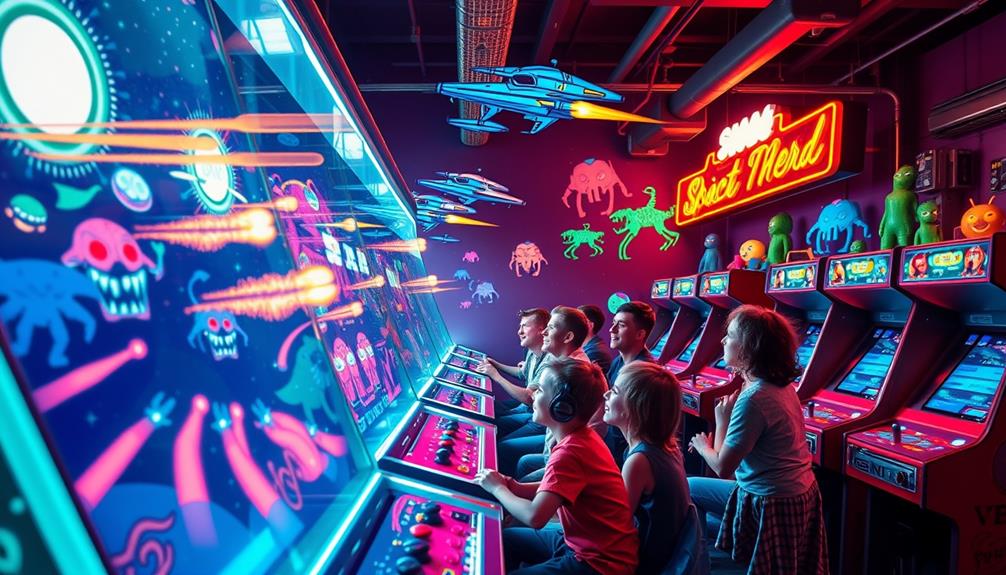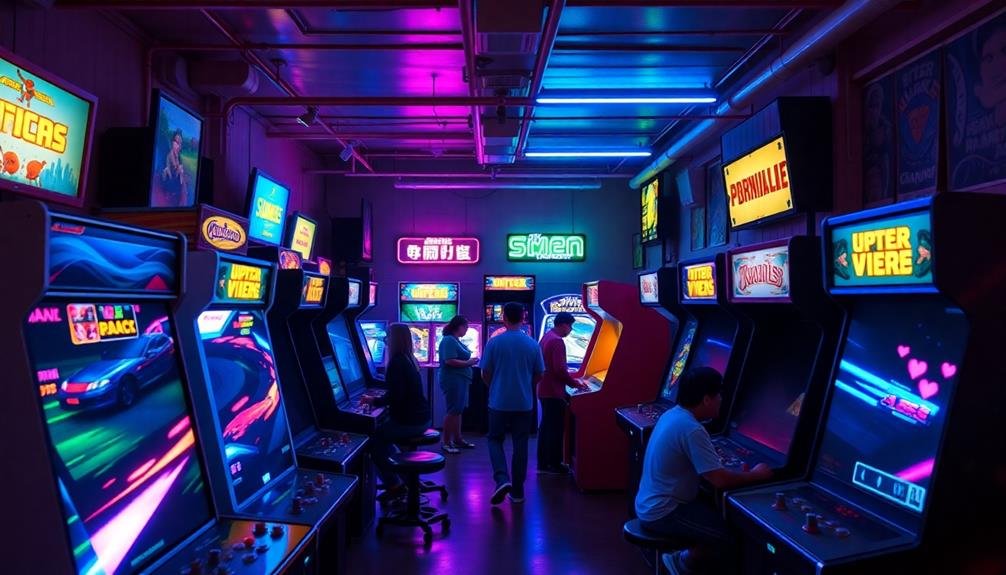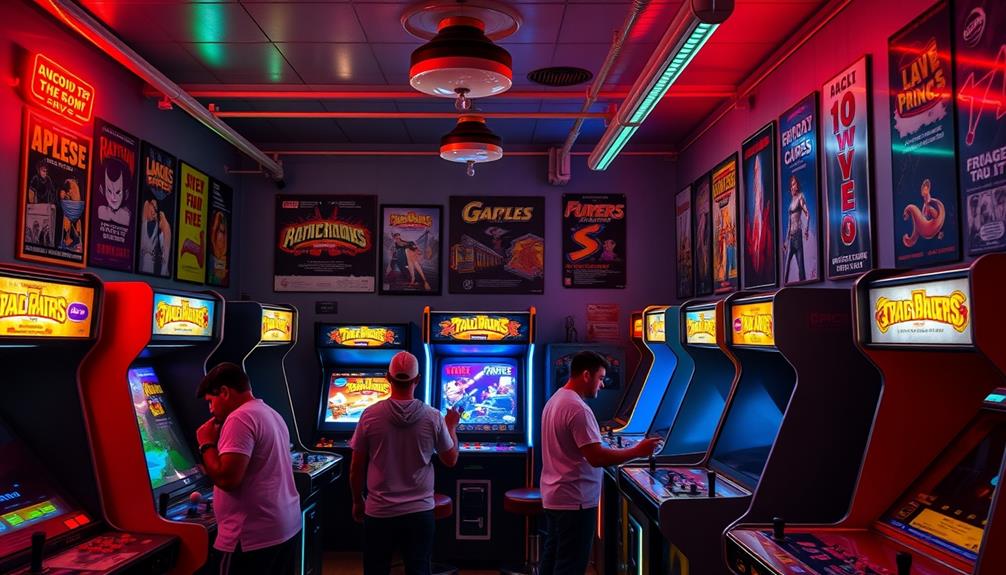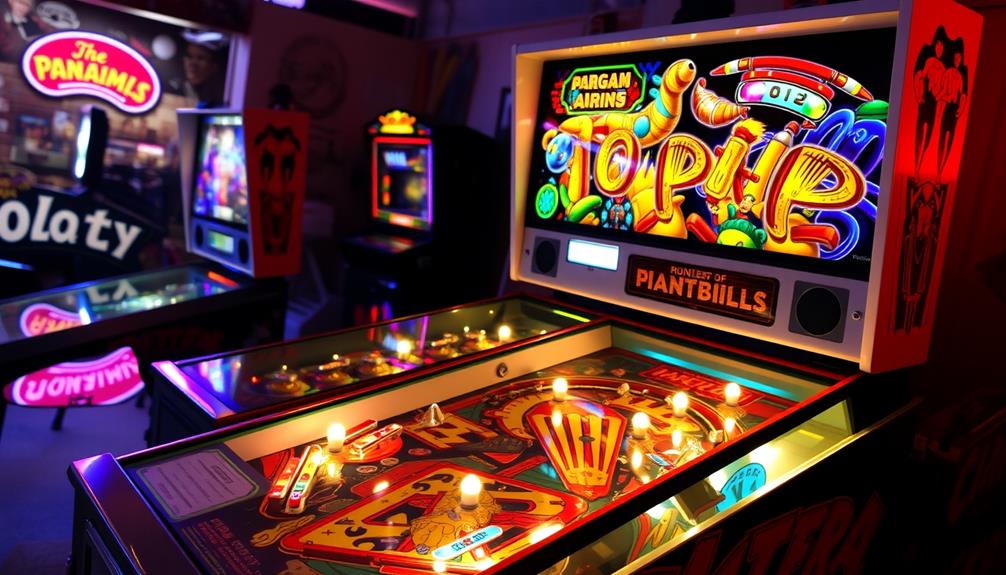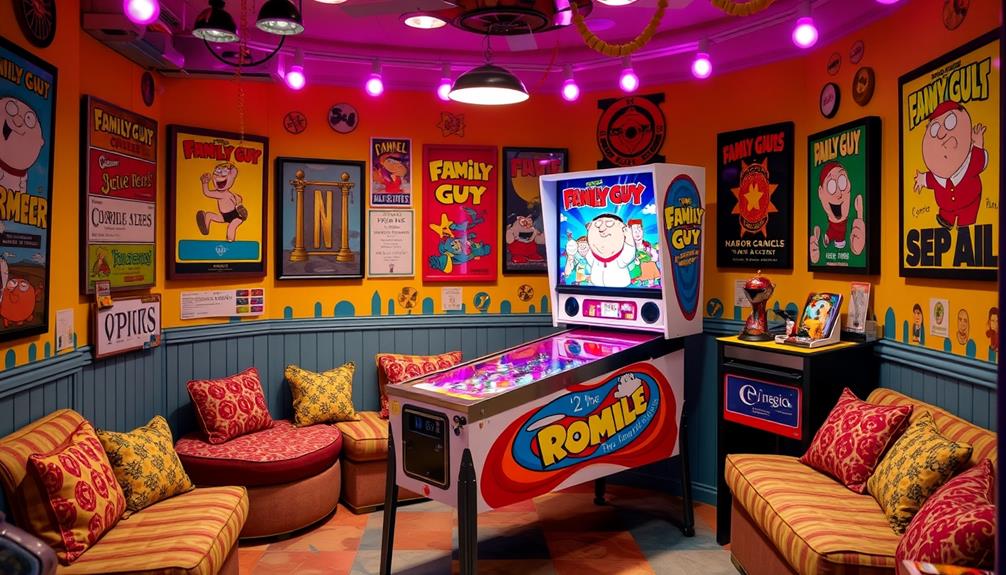Arcade games in the 80s typically ranged in price from $2,000 to $4,200. Classic games like Pac-Man started at approximately $2,400, while more sophisticated machines like Dragon’s Lair could cost up to $4,200. Towards the end of the 80s, prices began to decrease, with games like Street Fighter 2 being priced around $1,900. These price fluctuations were a reflection of advancements in technology and the popularity of the games. The evolving prices not only made arcade machines more affordable but also had an impact on the gaming industry as a whole. Interested in learning more about how these prices influenced arcade culture?
Key Takeaways
- In the 1980s, arcade machines typically ranged in price from $1,900 to $4,200, depending on the title and technology.
- Iconic arcade games like Pac-Man and Dragon's Lair were priced around $2,400 and $4,200, respectively.
- By the late 80s, the average cost for machines decreased due to technological advancements, with Street Fighter 2 priced at $1,900.
- Lower-end arcade machines could be found for as little as $2,000, making them more accessible to operators.
- Prices fluctuated throughout the decade, reflecting the popularity and innovation of the games released at the time.
Cost Overview of Arcade Games
When you think about the cost of arcade games in the 80s, it's clear that these machines were quite an investment. The average price for arcade machines ranged from $3,000 to $4,000, which is a hefty sum even today. The cost of arcade games was not just limited to the initial purchase price. Operators also had to consider the ongoing expenses of maintenance, repairs, and overhead costs for the arcade itself. Additionally, the popularity of certain games would often dictate how much revenue they would generate, further impacting the overall cost of arcade games for operators. Despite the high cost, arcade games were a staple of entertainment for many people during the 80s. Popular arcade games such as Pac-Man, Donkey Kong, and Space Invaders attracted large crowds and generated significant income for operators. The high demand for these games meant that operators were willing to invest in them, despite the steep upfront and ongoing costs. The allure of these popular arcade games kept players coming back for more, making the investment in arcade machines worth it for many operators.
If you were eyeing iconic titles like Pac-Man, you'd have to shell out around $2,400, roughly equivalent to $7,000 today. Meanwhile, more advanced machines like Dragon's Lair could cost you about $4,200, while the fun of Teenage Mutant Ninja Turtles would set you back around $4,000.
During this era, the gaming revolution was also influencing other genres, including pinball machines, which were evolving with new design features and technology the evolution of pinball machines.
You might find lower-end arcade machines for about $2,000, making them a bit more accessible for operators looking to fill their video arcade.
While the initial costs were steep, it's worth noting that prices started to decrease over time as production technology improved. This meant more opportunities for operators to invest in a wider selection of games.
Evolution of Arcade Machines

Throughout the 1980s, arcade machines underwent a remarkable transformation that reshaped the gaming landscape. You'd see the introduction of iconic video games like Space Invaders and Pac-Man, which not only captivated players but also fueled a boom in arcade establishments.
As technology advanced, so did the design and functionality of arcade machines, with many best arcade machines for home game rooms becoming available for personal use. They evolved to offer more complex gameplay and improved graphics, leaving earlier models in the dust.
Prices for these machines began to decrease, thanks to production advancements, making them more accessible for operators. This accessibility encouraged even more establishments to invest in arcade machines, contributing to the vibrant arcade culture of the decade.
Notable titles like Teenage Mutant Ninja Turtles and Outrun marked a shift towards cooperative and immersive gameplay experiences. You could now team up with friends, making the gaming experience even more engaging.
Iconic Arcade Games of the Era

Let's explore some of the iconic arcade games that defined the 80s and their pricing trends.
You'll see how titles like Pac-Man and Dragon's Lair not only captured players' attention but also shaped gaming culture. These games weren't just entertainment; they left a lasting impact on the arcade landscape.
In fact, much like how Nikki Reed and Ian Somerhalder promote a sustainable lifestyle as a couple, these games encouraged communities to gather and socialize in vibrant arcade environments.
The competitive spirit fostered by these titles contributed to the cultural phenomenon of arcades during this vibrant decade.
Game Pricing Trends
In the 1980s, arcade game pricing often reflected the evolving technology and gameplay experiences of the era. As you explored the arcades, you'd notice how the prices varied greatly based on innovation and multiplayer capabilities. This decade saw a shift in game pricing trends, where the cost of arcade machines began to fluctuate depending on their complexity and technology.
Here's a look at some iconic arcade machines and their prices:
| Game Title | Price (1980s) |
|---|---|
| Pac-Man | $2,400 |
| Dragon's Lair | $4,200 |
| Teenage Mutant Ninja Turtles | $4,000 |
| Outrun | $3,500 – $5,000 |
| Street Fighter 2 | $1,900 |
These prices highlight how the arcade landscape was changing. For instance, while Pac-Man set a high standard, later titles like Street Fighter 2 showcased a trend towards more affordable options. The premium prices for multiplayer experiences, like Teenage Mutant Ninja Turtles, reflected the growing demand for cooperative gameplay, making it clear that game pricing trends were influenced by both innovation and player engagement.
Iconic Titles Overview
While the 1980s ushered in a wave of innovation in arcade gaming, it's the iconic titles that truly defined the era and captivated players. Each game not only showcased technological advancements but also offered unique experiences that drew crowds to arcades across the globe.
The importance of diversification in entertainment, much like the diversification of retirement portfolios through options like a Gold IRA, became evident as players sought various gaming experiences.
- Pac-Man: The top-selling arcade machine of the decade, famously known for its maze-chasing gameplay.
- Dragon's Lair: A groundbreaking title featuring animated graphics, despite some gameplay criticism.
- Outrun: A thrilling driving game that pushed the limits of arcade technology, making it a favorite among racing enthusiasts.
- Teenage Mutant Ninja Turtles: A four-player co-op game that revolutionized multiplayer experiences in arcades.
These iconic titles weren't just games; they became cultural phenomena, each with a price tag reflecting their significance.
For instance, Pac-Man cost around $2,400, and Dragon's Lair stood at $4,200, showcasing the willingness of players to invest in unforgettable experiences.
The 80s solidified the legacy of these arcade games, creating a lasting impact that resonates even today.
Cultural Impact Analysis
The 1980s arcade games left an indelible mark on popular culture, influencing everything from fashion to music. Iconic arcade machines like Pac-Man became cultural phenomena, enchanting players with their vibrant graphics and addictive gameplay. Priced around $2,400 at launch, it's hard to imagine the $7,000 equivalent today, yet it was worth every penny for fans.
During this transformative time, notable events such as Billy Gilmans secret wedding showcased the era's enchanting social gatherings.
Dragon's Lair, released in 1983, showcased groundbreaking animation, although its mixed gameplay reviews highlighted the era's experimental spirit. Meanwhile, Teenage Mutant Ninja Turtles made waves in 1989 as a four-player co-op video game, reflecting the growing trend of multiplayer experiences. Priced at about $4,000, it fostered camaraderie among players, making arcade visits a social event.
Street Fighter 2, which emerged in 1991, revolutionized competitive gaming dynamics, costing around $1,900 and setting a standard for future console titles.
The success of these arcade games laid the groundwork for modern gaming culture, as their influence continues to inspire new games and adaptations today. You can see their legacy in contemporary video games, proving that the 80s arcade scene was more than just a trend; it was a cultural shift that shaped the future of gaming.
Pricing Trends Over the Decade

How did pricing trends for arcade machines evolve throughout the 1980s? During this decade, prices fluctuated markedly, influenced by technological advancements and popular titles. Initially, you'd find machines like Pac-Man priced around $2,400, while more sophisticated options like Dragon's Lair could soar up to $4,200.
As the gaming industry grew, the introduction of high-quality graphics and sound drew parallels to advancements seen in top projectors for gaming enthusiasts, further enhancing the overall experience.
- Popular games drove prices higher, especially for titles like Outrun and Teenage Mutant Ninja Turtles, which ranged between $3,500 and $4,000.
- As production techniques improved, the average price of arcade machines gradually decreased by the decade's end.
- Classic games from earlier years set a baseline, but the rise of iconic 80s titles saw a shift in pricing trends.
- By the late 80s, machines like Street Fighter 2 were available for about $1,900, showcasing a wider range of affordability for arcade enthusiasts.
Features of Popular Arcade Games

When you think about popular arcade games from the 80s, you'll notice their unique gameplay mechanics that kept players hooked.
The exciting blend of action and strategy in games like Galaga and Space Invaders was also essential in shaping the arcade landscape.
From the maze of Pac-Man to the cooperative action in Teenage Mutant Ninja Turtles, each game offered something distinct.
Plus, the visual and audio design, like the stunning animation in Dragon's Lair, elevated the gaming experience to a whole new level, showcasing how these early titles paved the way for future innovations in gaming, including the best rated pinball machines of 2024.
Unique Gameplay Mechanics
In the vibrant world of 80s arcade games, players discovered innovative gameplay mechanics that set these titles apart from one another.
These unique gameplay mechanics not only captivated players but also created lasting memories, reflecting a time when creativity and user experience were paramount in design, much like the principles found in design thinking.
Here are some standout features from iconic arcade machines of the era:
- Pac-Man (1980): Introduced maze-chase mechanics, where you navigated a labyrinth while dodging ghosts.
- Dragon's Lair (1983): Revolutionized gameplay with cinematic animation and quick-time events, though it faced mixed reviews.
- Teenage Mutant Ninja Turtles (1989): Allowed four players to team up in cooperative gameplay, enhancing the social aspect of arcade gaming.
- Outrun (1986): Offered a cockpit-style cabinet that immersed players in a driving experience like no other.
These unique gameplay mechanics defined the gaming culture of the time, prompting players to return to their favorite arcade machines again and again.
Whether you were strategizing your next move in Pac-Man or coordinating with friends in Teenage Mutant Ninja Turtles, each game brought a fresh approach to the arcade experience, making those moments unforgettable.
Visual and Audio Design
Amid the neon lights and buzzing sounds of 80s arcades, visual and audio design played an essential role in attracting players and enhancing their gaming experience. The colorful graphics of games like Pac-Man drew you in, while catchy soundtracks and sound effects kept you immersed in the action.
Engaging in music-making, much like the rhythmic sound effects of these games, fosters creativity and self-expression, enhancing overall enjoyment. Dragon's Lair stood out with its groundbreaking animation technology, offering a visually distinct experience, even if gameplay opinions were mixed.
Coin-operated machines like Outrun introduced cockpit-style designs, making you feel like you were really behind the wheel, complete with a steering wheel and pedals. Teenage Mutant Ninja Turtles brought friends together with its four-player co-op feature, showcasing vibrant character animations and memorable sound bites that echoed throughout the arcade.
The integration of sound and visuals in these games was akin to the healing properties of sound therapy, which has been shown to reduce anxiety and enhance overall well-being sound healing science.
Street Fighter 2 revolutionized fighting games with a diverse roster of characters, each boasting unique special moves. The detailed graphics and audio cues for character attacks created an engaging atmosphere that kept players coming back for more.
In the 80s, visual and audio design weren't just enhancements; they were integral to the arcade experience, making every coin you dropped worth it.
High-End Machines and Their Costs

High-end arcade machines in the 1980s captivated players not just with their gameplay but also with their steep price tags. If you wanted to experience the cutting-edge technology of the time, you'd need to dig deep into your pockets.
Investing in these machines was akin to making a significant financial commitment, reflecting the era's enthusiasm for innovation and entertainment. Here are some standout examples of those high-end machines and their costs:
- Dragon's Lair: Priced around $4,200, it was one of the most expensive machines.
- Pac-Man: Costing about $2,400, it translates to roughly $7,000 today when adjusted for inflation.
- Outrun: This popular driving game ranged from $3,500 to $5,000, reflecting its advanced features.
- Teenage Mutant Ninja Turtles: A four-player co-op game that launched in 1989 for around $4,000.
These prices illustrate the significant investment in arcade technology during the era. Some high-end machines even reached staggering amounts, like Galaxian, which was priced as high as $20,000 at its introduction.
It's clear that owning a high-end arcade machine was a bold statement, showcasing the evolution of gaming and the desire for immersive experiences. This trend parallels the importance of diversification strategy in financial investments, highlighting the need to balance risks and rewards.
Influence on Modern Gaming

The groundbreaking designs and innovative gameplay mechanics of 1980s arcade machines have left a lasting mark on modern gaming. Iconic titles like *Dragon's Lair* and *Mortal Kombat* paved the way for the genres you enjoy today. The evolution of these arcade games introduced features such as character selection and special moves, which have become staples in today's consoles and PC games.
In particular, the fighting genre flourished thanks to *Street Fighter 2* and *Mortal Kombat*, setting new standards for gameplay that you see in many modern titles. Multiplayer experiences, often fostered in arcade settings, laid the groundwork for today's online gaming culture. The competitive nature of 80s arcades encouraged social interaction that echoes in today's co-op and multiplayer games.
Moreover, the nostalgia for classic arcade games has led to a resurgence in retro-themed games, many of which are now available on mobile platforms. This keeps the spirit of arcade gaming alive, showing just how influential those early designs were in shaping the gaming landscape you know and love.
The legacy of 1980s arcade machines continues to resonate throughout the gaming community.
Accessibility of Arcade Games

During the 1980s, accessibility to arcade games expanded remarkably, allowing more players to enjoy these enchanting experiences. The introduction of lower-end arcade machines priced around $2,000 made it possible for smaller operators to enter the market. As production techniques improved, prices for arcade machines continued to decline, broadening access even further.
- Iconic games like Pac-Man brought excitement to malls and restaurants.
- Public venues became hotspots for gamers of all ages.
- Operators could invest in a variety of games to attract diverse crowds.
- The buzz surrounding arcade games created a vibrant social scene.
These factors combined to make arcade machines a familiar sight in various public spaces, from shopping centers to family-friendly restaurants.
As a result, players could easily find and access their favorite games without traveling far. The growth of arcade culture during this decade transformed how people engaged with gaming, fostering a community where everyone could join in the fun.
Not only did this boost the popularity of arcade games, but it also set the stage for the gaming evolution that followed in subsequent years.
Legacy of 1980s Arcade Culture

Arcade culture from the 1980s left an indelible mark on the gaming landscape, shaping how players interact with games today. The era introduced iconic machines like Pac-Man, which became a cultural phenomenon, selling for around $2,400—roughly $7,000 today. This was just the beginning.
Multiplayer games like Teenage Mutant Ninja Turtles in 1989 encouraged social interaction and co-op gameplay, letting you team up with friends in an arcade setting.
You also experienced unique gaming styles, such as Outrun's driving cockpit, which influenced future racing games. The engaging nature of arcade machines laid the groundwork for fighting games, with titles like Street Fighter 2 shaping competitive gaming culture.
The legacy of 1980s arcade culture continues to resonate today. Many classic games are being reimagined for consoles and mobile devices, keeping their appeal alive for new generations.
The social aspects, thrilling gameplay, and innovative designs from the first arcade experiences fostered a love for gaming that endures. Now, when you pick up a controller, you're tapping into a rich history that started in those bustling arcades.
Frequently Asked Questions
How Much Did Arcade Machines Cost in the 80S?
In the 80s, arcade machines' costs ranged widely. You'd find popular games near $2,400, while advanced ones could hit $4,200. Prices often reflected the game's complexity and popularity, impacting your gaming experience.
How Much Did Games Cost in the 80S?
In the 80s, you'd find popular cassette tapes priced around $10, while vinyl records could hit $20. Video games typically sold for $30 to $50, making them a treasured addition to your collection.
What Was the First Arcade Game to Cost 50 Cents?
The first arcade game to cost 50 cents was "Dragon's Lair." Its groundbreaking animated graphics and advanced technology set a new standard, influencing pricing strategies for future games and making it a landmark in arcade history.
What Was the Biggest Arcade Game of 1980?
You step into the arcade, eyes scanning for the sensation of 1980—Pac-Man. This iconic game, with its unique maze and ghostly challenges, captivated players and ignited a gaming revolution that changed everything. Are you ready to play?
Conclusion
To summarize, the 1980s arcade scene was a vibrant hub of entertainment, with games costing anywhere from a quarter to a dollar. You could easily spend your allowance on classics like Pac-Man and Donkey Kong, experiencing the thrill of high scores and pixelated adventures. The legacy of those machines still influences today's gaming landscape, proving that some retro vibes are timeless—just like your favorite retro playlist! So grab some tokens and relive those arcade glory days!


